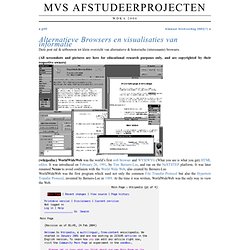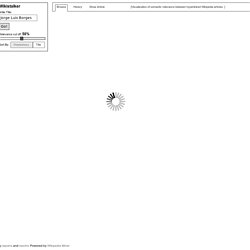

Back – Space. Back-space is an interactive installation exploring the spatiality of cyberspace in our wanderings and investigations.

It tries to bring to focus our everyday dwelling with huge amount of interconnected information and the way we move in this space by using hyperlinks. Spatial distance has always been an obstacle to accessibly. Historically technological progress has advanced in the direction of reduction or eliminating distance and erasing the differences between far and near. This compression of space was first become more noticeable with the spread of telegraph and railroads.
Now cyberspace delivers the ultimate annihilation of space by making every destination effortlessly accessible and making every point uniformly distance-less. I believe access, nearness, distance and perspective play crucial roles in our ability to comprehend at both cognitive and aesthetic levels. AquaBrowser Library ® - Edinburgh University Library. MvS afstudeerprojecten » Alternatieve Browsers en visualisaties van informatie. Meer een kunstwerk dan daadwerkelijk browser, maar weer een andere visie op browsen «WebStalker» is a browser that imitates the structure of the Internet.

If the user types in a WWW-address, the page appears as an HTML-code while the hyperlinks are presented as graphics. «WebStalker» was developed by a team of programmers and artists as an indirect critique of large web concerns’ inspiring illusion of actually being able to move when ‹clicking› one’s way through the Internet. Settled between technological development work and art, this project demonstrates a simple and reduced alternative to Netscape and Explorer, and makes available a mechanism that can be used to investigate the structural depths of the web. Contributors were: Graham Harwood, Stephen Metcalf, Scanner, Mark Amerika. (by: Heike Helfert) AquaBrowser (Associatief zoeken door bibliotheken): SHREDDER browser (siteshredding…) Medusa kulturtechnisches werkzeug fur den zugang zu kollektivem wissen.
Wikistalker - Wikipedia Article Structure Visualization sss. Wikistalker illustrates the relations between different things by visualizing the semantic relevance between the inter-connected structure of their Wikipedia entry articles.

In this visualization, each bar (or ray) represents an outgoing link from the Wikipedia article with its length corresponding to the semantic relevance of two connected articles. You can filter links by their relatedness using the sliding bar and sort them alphabetically or by relevance. Hyperlinks, once being an addition to the textual content, now in many cases are as significant as the content itself. In Wikistalker this idea is pushed to its limits by removing the content and only showing the structure of hyperlinks. It also revisits the idea behind Web Stalker, visualizing the structure and connections between different elements of cyberspace, instead of showing the content. This project is implemented in HTML5 using d3.js and jquery Developed by sepans. Back to the Future.
Btf-D18 07.07.11 BACK TO THE FUTURE: Hypertext the Way It Used To Be Theodor Holm Nelson and Robert Adamson Smith Project Xanadu ABSTRACT.

Others imitate paper (Word, Acrobat) and the constant 3D world we live in ("Virtual Reality"). Our system instead tries to create documents better than paper in a space better than reality. Intellectual property notice: The following are trademarks of Project Xanadu, registered or claimed: Xanadu, ZigZag, XanaduSpace. The purpose of hypertext was always to make up for the deficiencies of paper.
. - been one-way - not allowed overlapping of either source or target endsets ("anchors") - not had types This crude structure has been a source of regret for which some of us have apologized in print (2). We are not just building a different kind of hypertext, but seeking the most general form of document. . - rectangular pages - text stramers and "crawls" - overlays - flying paragraphs - fountains of text - rippling surfaces - animated and changing texts Fig. 2. 0. Articles » L’hypertexte, une technologie intellectuelle à l’ère de la complexité – Jean Clément.
Dans son article « L’hypertexte, une technologie intellectuelle à l’ère de la complexité » Jean Clément pose un regard épistémologique sur l’hypertexte et souligne la double dimension de concept et de technologie pour ce terme inventé par le philosophe Théodor Holmes Nelson en 1965.

Il y propose que le préfixe « hyper » est moins caractérisé par sa valeur superlative qu’orienté par un sens mathématique : « l’hypertexte est un texte à n dimensions ».